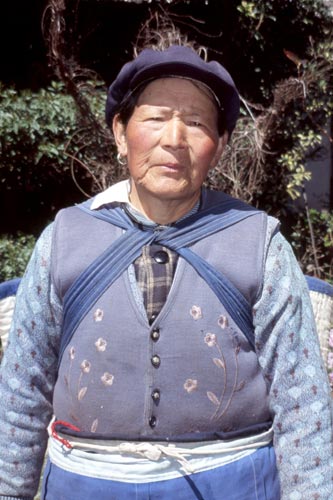
A friendly woman who invited me for tea
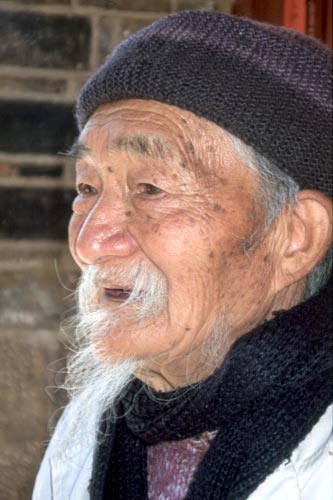
Dr. Ho likes to have travelers drop by for a chat.
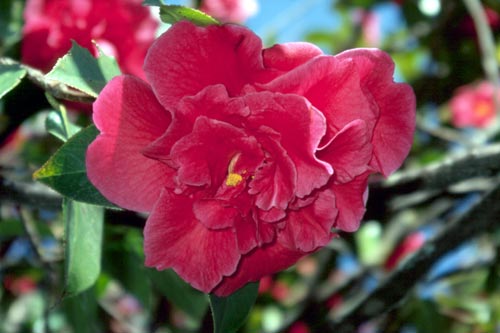
The "Camellia Tree of 10,000 Blossoms" at Yufeng Temple,
just north of Baisha at the foot of Jade Dragon Snow Mountain
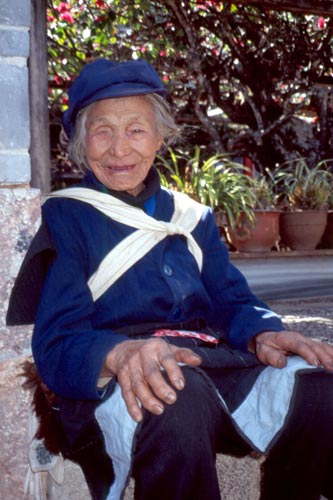
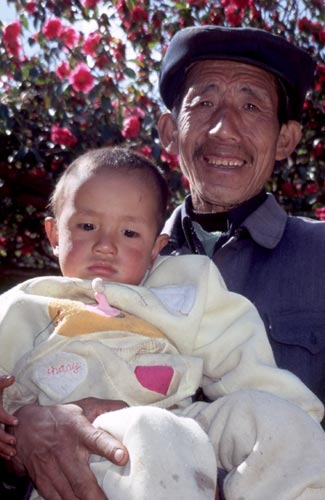
Zhongdian, China
26 March 2005
Encountering yaks and snow
Dear Friends and Family,
Neither yaks nor snow could keep me from reaching this large Tibetan/Chinese town yesterday! It's cold (near freezing) here at an elevation of 3,200 meters (10,500 feet). Yesterday I rode through a snowstorm and had to walk some slippery snow sections on a pass. Today the snow has melted in town, but surrounding mountains shine with white.
I really enjoyed my four-day stay in Lijiang. On the third day I hopped on Bessie Too and rode north to the village and former Naxi capital of Baisha. While wandering the picturesque stone lanes, a woman invited me to her garden for tea. She didn't speak much English, but liked to have foreign visitors. Another friendly folk—Dr. Ho—hailed me as I pedaled by his clinic. He had become famous for his herbal medicines collected from nearby Jade Dragon Snow Mountain. Even patients with serious diseases such as leukemia had been cured with Dr. Ho's herbal concoctions. He invited me into his clinic and plied me with one of his teas, composed of six herbs, while regaling me with tales of famous people who had visited and showed me books and magazine articles about his life. Past visitors included actor John Cleese, who noted, "Interesting chap; crap tea."
Continuing north from Baisha I climbed up to the small Tibetan temple of Yufeng Si, renowned for its "Camellia Tree of 10,000 Blossoms." I didn't verify the number, but the profusion of pink blossoms made a wonderful sight. Locals flocked to the tree to have their pictures taken in front of it, and I joined in the fun too. Back in Baisha, I never would have suspected that the rustic village had once been the capital of a large region, but stepping inside the palace complex and seeing the 15th-16th century temple frescoes showed the importance of the site. The frescoes illustrated Buddhist scenes with fine realism and color despite the passage of so many centuries.
| A Visit to Baisha | |
 A friendly woman who invited me for tea |
|
 The "Camellia Tree of 10,000 Blossoms" at Yufeng Temple, just north of Baisha at the foot of Jade Dragon Snow Mountain |
|
 |
 |
One of Lijiang's big attractions is the traditional music concerts. The Naxi have preserved classical Chinese music of the past 2,000 years that has largely been lost elsewhere in the country. Many of the musicians were up in their 80s, having learned the pieces before Chairman Mao's persecutions had suppressed the old traditions during the "Cultural Revolution." The music tended to be very stately and refined, as you would expect, with a huge gong and other percussion to add gravity. Naxi folk songs provided a lighter touch.
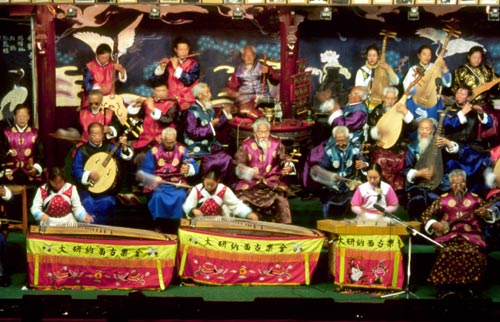
Ancient tunes played by musicians of the Naxi Music Academy, old town Lijiang
The next morning I wandered through the vast Mu Family Mansion, a reconstructed complex patterned after the Forbidden City of Beijing. Naxi chieftans, loyal to the Chinese emperors (a point stressed by the explanations), administered local affairs here. I enjoyed the architecture, flower-lined courtyards, and art exhibits.
| Exploring the Mu Family Mansion in old town Lijiang | |
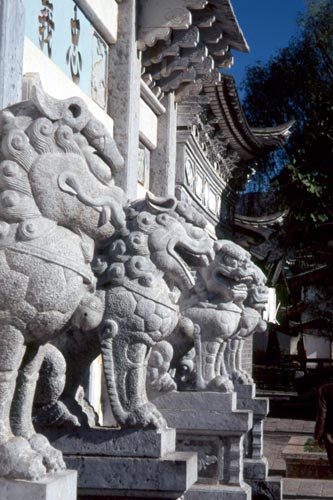 Four stone lions guard the main gate. |
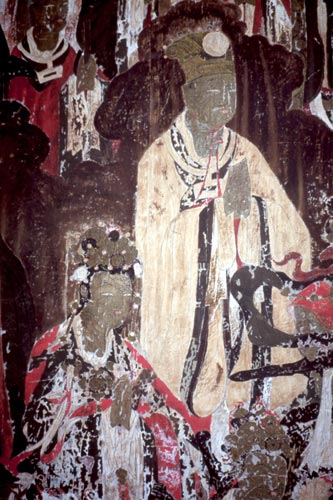 Baisha fresco reproduction in Royal Voice Pavilion |
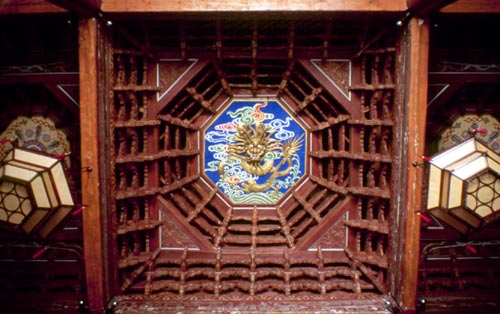 Dragon on ceiling of Main Hall |
|
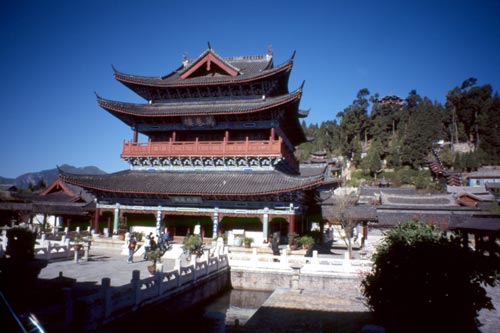 Thousand Volume Book Building You can see the top of Wanggu Lou pagoda above the trees on the right. |
|
That afternoon I pedaled southwest up into the forested mountains to visit Wenbi Si, a Tibetan monastery dating from 1733. The main hall had several large Buddhas and a library. I listened to monks practicing religious music with horns and an oboe-like instrument; the monks had a ways to go before mastering their musical arts, but it was good to see an active monastery.
| Wenbi Si | |
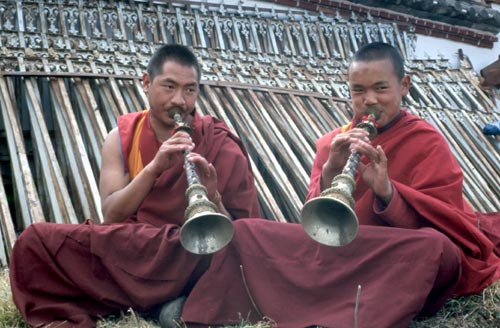 Sour sounds from aspiring musicians The double-reed gyalings sound like an oboe. |
|
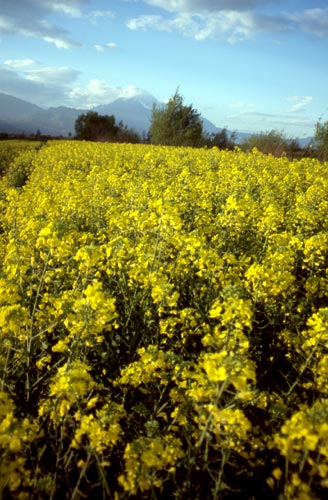 Rapeseed fields glow in the late afternoon light on the road to the monastery. |
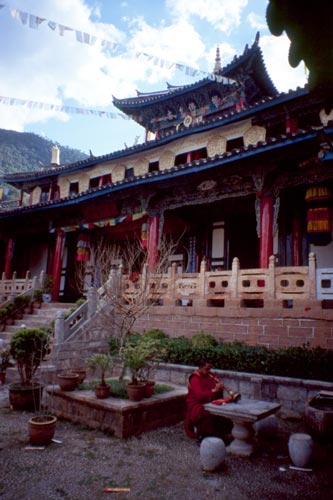 Courtyard and main temple |
The Yangzi River has such an important place in Chinese history that I just had to see the First Bend that made it all possible. The river swings around nearly 180 degrees opposite Cloud Hill, which is just a modest lump of rock. Apparently no one really knows why the mighty river makes such a dramatic turn here. I stayed in the nearby town of Shigu, visited the monument to People's Army's Long March of 1936, and wandered among the adjacent villages and fields of bright green and yellow.
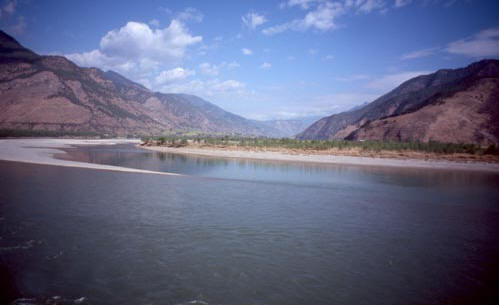
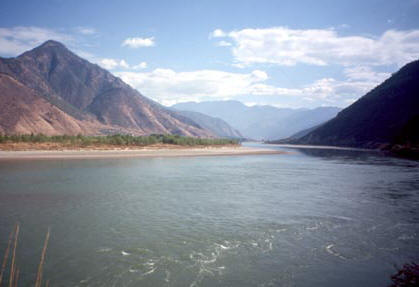
First Bend—originating from Tibet in the north, the Yangze River curves
nearly 180° back to the north where we are standing.
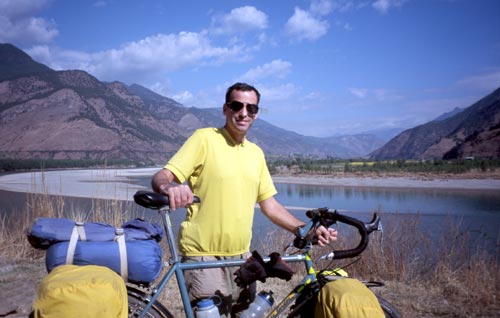
Bill and "Bessie Too the Bicycle" at First Bend
The next day I followed the Yangzi downstream into Tiger Leaping Gorge, where the placid river breaks into horrendous rapids. I hiked down to the Upper Rapids, a great tumult of water exploding into waves and holes, and crashing into massive boulders. Continuing through the gorge, I stopped at Sean's Spring Guest House, a popular overnight destination for trekkers and a good place to meet other travelers—I think I saw more here in three days than in the previous two months. Sheer gray cliffs rose nearly 2,000 meters across the gorge. An exciting trail led down to the Middle Rapids, as thunderous as the Upper, but here I could follow plank bridges out onto boulders in the midst of the whitewater—very exciting and a bit dangerous; this is the spot where a tiger was said to leap across. I also wanted to see the gorge from the upper trail, which provides a very different perspective. I started from the west end and climbed through a series of alpine villages, then up the Twenty-Four Bends to the highest and most dramatic section, with great views of the gorge and a pretty forest with a grove of flowering rhododendrons. Father along, the trail crossed open country and traversed sheer cliffs at a large waterfall. After eight hours, and darkness nearing, I made it back safely to the guesthouse.
| Deep Into the Depths of Tiger Leaping Gorge |
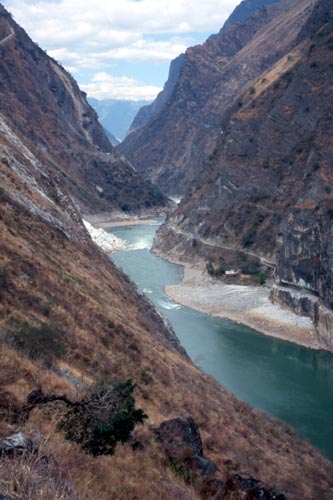 We are entering Tiger Leaping Gorge from the west by road; trails lie high above on this slope and near river's edge on the other side. |
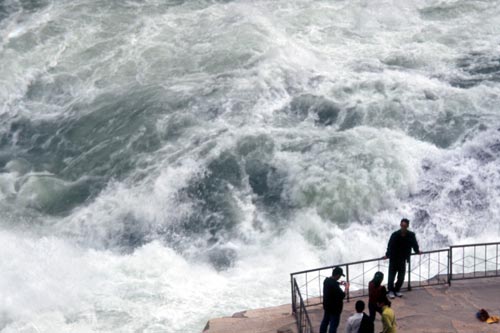 A short trail leads down from the road to this tumultuous Upper Rapids. |
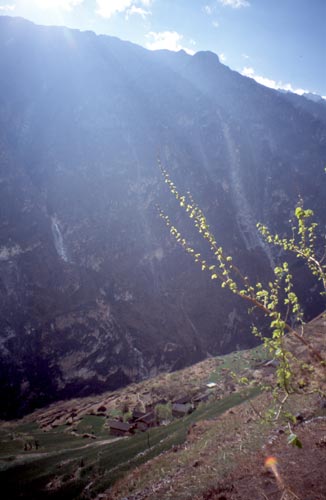 On this beautiful morning, I'm hiking down from my guest house at Walnut Grove to another raging rapid and the spot where the tiger is said to have jumped across. |
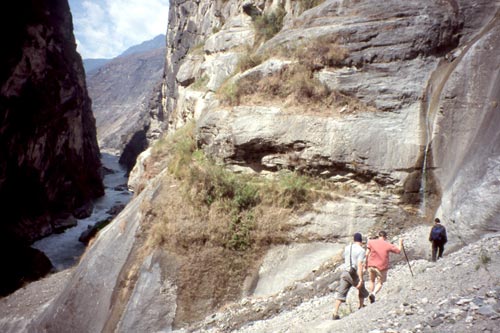 We are about half way down to the river and looking upriver. |
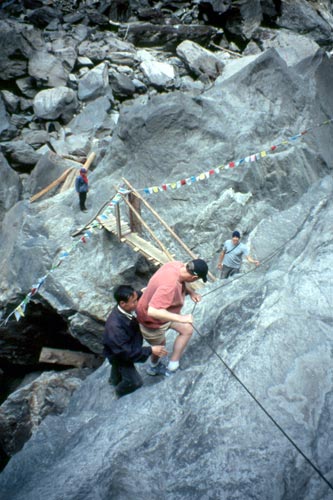 The last bit of trail is the trickiest! |
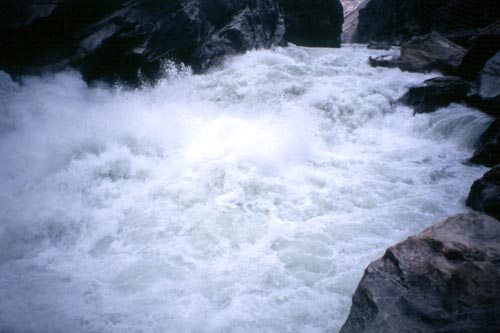 Too close for comfort, but what a spectacle—the Middle Rapids! A tiger is said to have leaped across near this spot. |
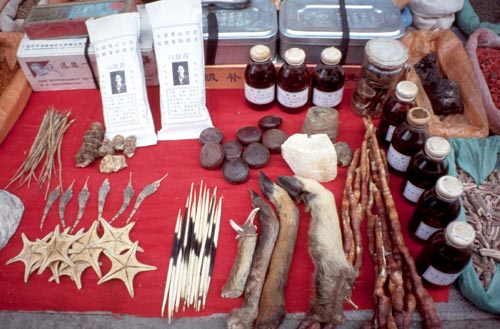 I started my Tiger Leaping Gorge hike from the town of Qiaotou. It was market day with fruit, vegetables, chickens, ducks, and traditional medicines—such as these—laid out on the sidewalks. |
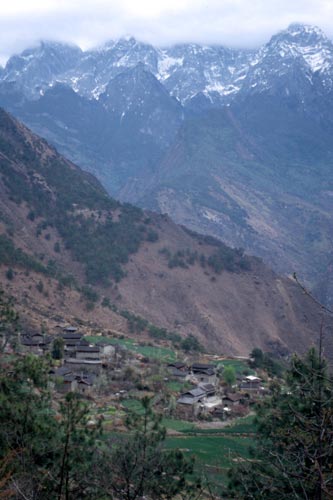 I've climbed high on the upper trail for this view of Nuoyo village. |
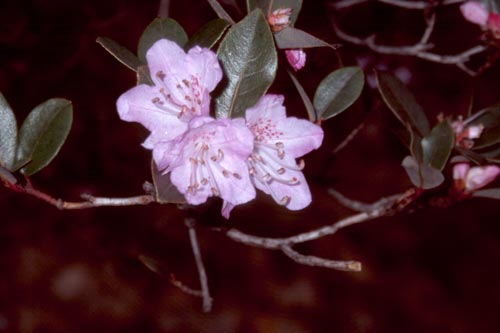 Rhododendron blossoms along the upper trail |
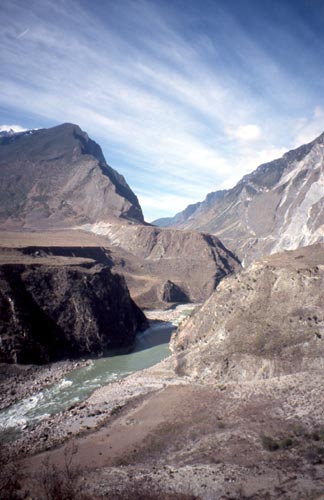 The lower end of Tiger Leaping Gorge You can see the road high on the slopes in the distance on the right. |
The weather had been gradually deteriorating with lots of cloud and brief spells of drizzle, so I was happy the next morning to see sunshine and hop on the bicycle for the remaining distance down the gorge and out into a wide valley full of crops and villages. Here both the Yangzi and I turned north. The road climbed high up the side of Haba Snow Mountain (5,396 meters; 17,700 feet) with views of the great mountain to my left and occasional glimpses of the Yangzi in its deep valley to the right. Eventually the river and I separated. The immense valleys below and hillside-clinging villages reminded me of Nepal's hill country.
I stopped for the night in Baishuitai, famous for its travertine terraces, and stayed at a guesthouse run by two cheerful women. But rain fell that evening and all the next day. I stayed inside and gave Bessie Too an overhaul with new grease for the hubs and a tune-up in preparation for the mountainous roads to come. Clouds persisted the third day, but I walked a loop around the pale yellow terraces, which had some pretty pools of turquoise water. Baishuitai has a special importance for the local Dongba Buddhist religion; visitors burned incense and sprinkled offerings at shrines beside one of the terrace walls and at a spring. From Baishuitai, I began a 20-km climb to the first of three passes for the day. The clouds dropped a bit of drizzle, then began swirling around me. Village fields in the high country had only just been prepared for planting, the brown earth contrasted with the lush fields I had been seeing at lower elevations. Yaks, actually hybrids with cattle, watched me as I slowly pedaled along. By the third pass I was high above the villages and surrounded by a forest of moss-draped conifer trees. The drizzle turned to snow and I felt cold on the descent to the village of Jiulong, which thankfully had a guesthouse and a kitchen with a warm stove.
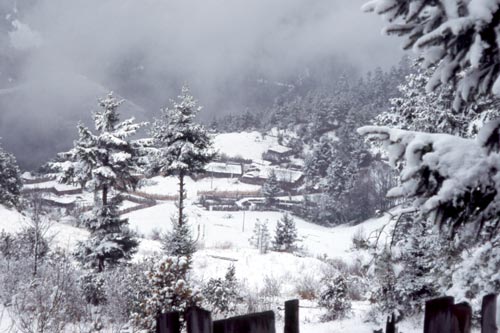
Upper
Jiulong village
When I looked out the next morning, all I saw was snow. Was the road to Zhongdian open? Could I possibly make it up and over the pass on a bicycle? Should I wait a day for the weather to improve? To find out, I hit the road, which immediately began an 11-km climb. I was able to follow the tracks of other vehicles, but when the pavement ran out near the pass, slippery snow made riding impossible, so I had to walk over the top. Heading down the other side, I splashed through some mud, but that was preferable to riding on snow. The surrounding hills displayed a stark black and white appearance—the snow and drifting clouds contrasting with the dark trees and shrubs. At the bottom of the pass, the road turned west into a stiff headwind, but I could actually ride faster because blissful asphalt had returned! Tibetan-style houses and open grasslands began to appear, announcing that I was entering the Tibetan world. Some rolling hills later, I entered Zhongdian and found my way to a guesthouse in the south part of town. I washed the mud off "Bessie Too," then headed over to the Noah Cafe for some tasty pizza and hot chocolate.
Today I took a local bus north several km to the most important Tibetan monastery complex in the region, Ganden Sumtseling Gompa, which dates back to 1679 and now has about 300 monks. It's actually a small town centered on multi-story temples filled with statues and colorful paintings of Tibetan lamas, guardian demons, mandalas, and even instructions for using monk's requisites. I explored the temples and wandered the muddy back lanes past houses and shrines. Ruined walls of old buildings stood in some places, but workers were shaping timbers and stones in the ongoing reconstruction. The sun came out now and then, shining off the gold roof and ornaments of the main temple, which towered about six stories; I climbed up for the views.
| Exploring Ganden Sumtseling Gompa | |
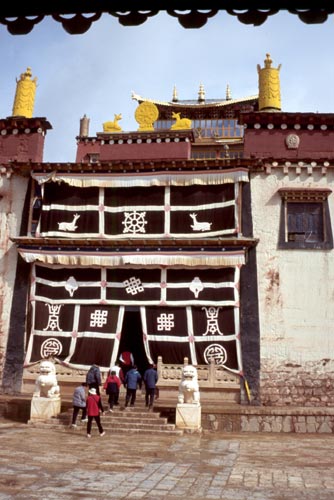 This is the entrance to one of the main temples. The deer and wheel symbolize the Buddha's first teachings. |
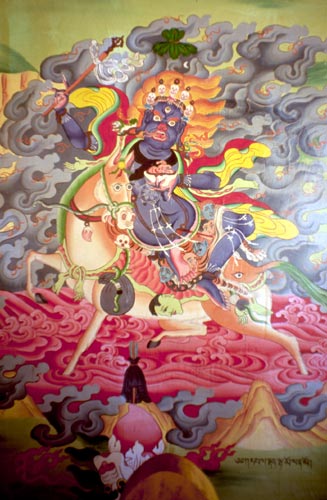 Palden Lhamo is a female protector of the Gelugpa (Yellow Hat) order, to which this monastery belongs. |
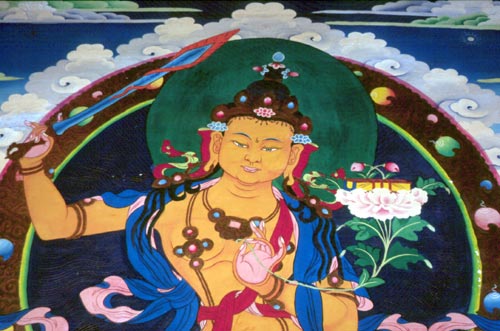 Manjushri (Jampelyang), the Bodhisattva of Wisdom, holds the flaming sword of awareness that will cut through ignorance. The lotus in his left hand supports scripture. |
|
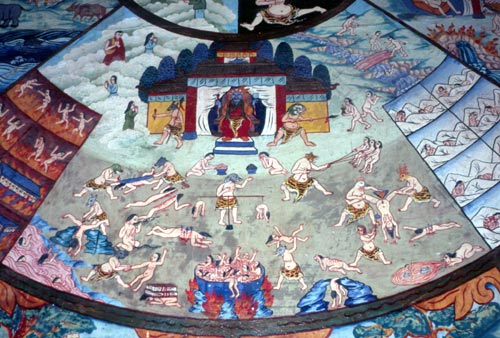 The Wheel of Life illustrates the cycle of rebirth and depicts the six realms where rebirth takes place. This is a detail of one of the realms. |
|
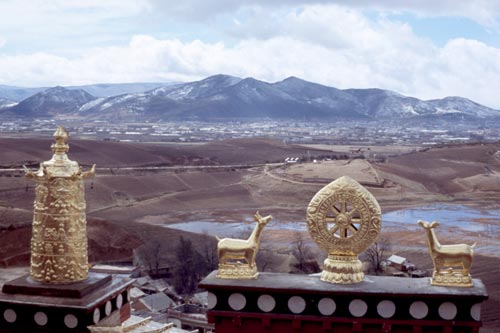 View of distant Zhongdian from a temple rooftop |
|
| Wandering in Zhongdian's old town | |
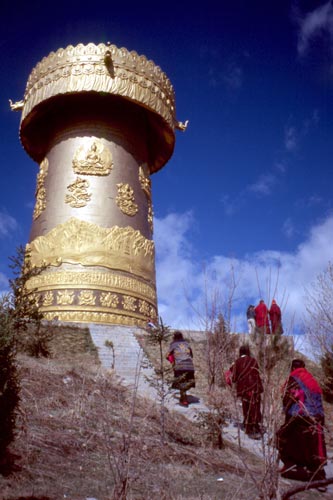 The entire shaft of this giant prayer wheel turns. |
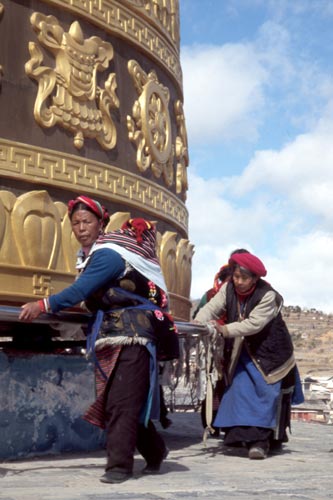 But it takes a bunch of people to turn it! |
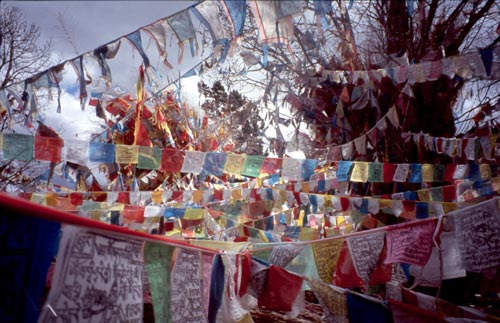 Prayer flags flutter in the breeze beside a small hill-top monastery. |
|
What will the weather do next? I hope to ride to Deqin, the last town before the Tibetan border, but I'll need a stretch of good weather to make it over the 4,200-meter (13,780-foot) triple pass. If the weather gods permit, I'll make a long descent to the Yangzi River, then head over the triple pass. Continuing a bit beyond Deqin, I'll reach the Mekong River and the 12-km-long Mingyong Glacier.
I've not met any other cyclists for a long time, but I have a printout of the story by a pair of cyclists who came this way a year ago on a very lengthy journey--Mark and Ju have much to say about their journey south across China at www.mark-ju.net.
From the snow mountains of northwestern Yunnan,
Bill Weir and "Bessie
Too the Bicycle"